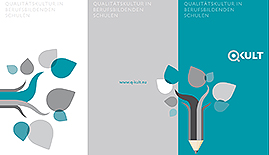Q-KULT Guide
During the project Q-KULT a instrument has been developed which can support vocational schools to apprehend their organisational culture. The instrument was developed in line with the assumption that every school has some kind of specific individual 'culture' that can also be assessed in terms of its own specific characteristics and is related (in a way that has yet to be defined) to the quality management system (and/or the quality procedure) used by the school in question.
Q-KULT Guide aims to provide a concrete description of the Q-KULT instrument for use in different potential applications in vocational schools. In order to do so, it initially classifies the concept of "culture". The guide also contains a number of considerations as to the situations in which the instrument can be used in schools and factors that need to be taken into consideration when using the instrument. The final part of the guide provides various information on interpreting the results provided by the instrument in the form of examples that may help schools to orient themselves when dealing with these results. The instrument itself is attached to this guide.
Please choose suitable language version and before starting to use the instrument, please get acquainted with the Guide for Q-KULT Online tool:
> DE - Q-KULT Handreichung: Analyse der schulischen Qualitätskultur mit dem Q-KULT Instrument
> EN - Q-KULT Guide: Using the Q-KULT Instrument to Analyse the Quality Culture in School
> DK - Q-KULT vejledning: Analyse af kvalitetskulturen i skoler vha. Q-KULT-instrumentet
> NL - Q-KULT handreiking: Analyse van kwaliteitscultuur op school met het Q-KULT-instrument


